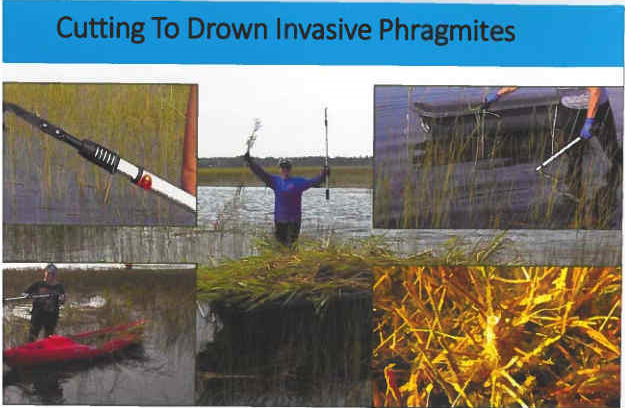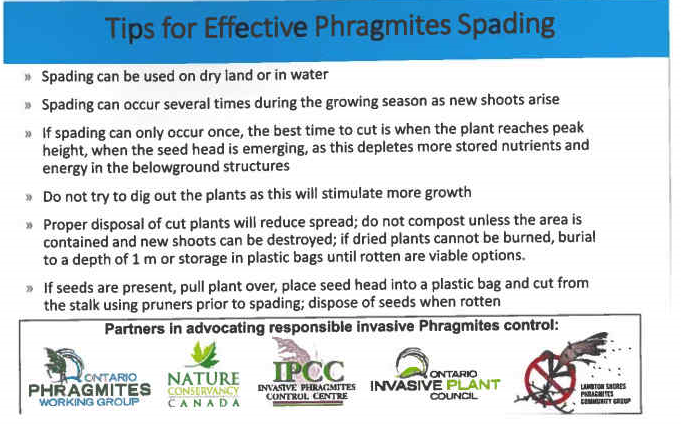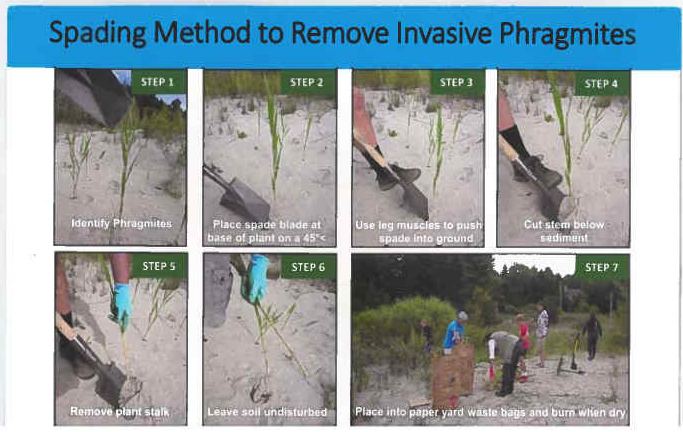INVASIVE SPECIES IN THE MUNICIPALITY OF MAGNETAWAN - PHRAGMITES AUSTRALIS & JAPANESE KNOTWEED
PHRAGMITES AUSTRALIS IN THE MUNICIPALITY OF MAGNETAWAN
Phragmites Autralis, is an invasive, non-native reed grass that has established itself in and around the shore of Old Man’s Lake as well as other areas within the Municipality of Magnetawan.
A group of six volunteers (residents from Old Man’s Lake), plus the chair of the Phragmites Working Group Lake Bernard recently removed a stand of this highly invasive Phragmites from a property on the north side of the lake. There is still a second stand that still needs to be removed from this side of the lake. Phragmites may be on your shoreline property and if so, you will want to remove it quickly. With a property owner’s help and permission, the Phragmites Working Group Lake Bernard may be able to show you what it is, and help you remove it, beginning with cutting it from your property or at least removing the seed head this fall. Raspberry Cane Cutters can be loaned to assist with the removal on your property.
To purchase your own cutters please visit:
https://www.leevalley.com/en-ca/shop/garden/garden-care/pruners/10242-raspberry-cane-cutter?item=ED725
Information about Phragmites has been posted on the following sites:
The Near North Enviro-Education Centre (NNEEC) https://www.nneec.ca/
Invasive Phragmites Control Centre https://www.phragcontrol.com/
Georgian Bay Forever https://www.georgianbayforever.org/
Ontario Invasive Plant Council https://www.ontarioinvasiveplants.ca/
Ontario’s Invading Species Awareness Program http://www.invadingspecies.com/
More Resources:
Invasive Species and Prevention Pathways of Spread
Phragmites: An Expensive Invasive Species in Ontario
Invasive Phragmites Control Fund
The Phragmites Working Group Lake Bernard
The Phragmites Working Group Lake Bernard has been locating and removing stands of Phragmites along the shoreline for three seasons. In some instances it has grown over 15 feet tall. Phragmites root mats spread up to 10 feet in a season and can be up to four feet thick, sending rhizomes (runners) up to 60 feet long, choking out other plant species such as cattails and preventing the free flow of water and streams. According to wetland biologists and invasive species experts, Phragmites do not serve as a food source for wildlife, and it is too dense to serve as effective cover or nesting grounds. In fact, it is deeply destructive to our recreational fishing as well as our local bird and other wildlife habitat.
If it goes unchecked, it will cause property owners’ shorelines to fill in and natural plants to disappear and the loss of biodiversity will cause additional stress to the natural ecosystem around the lake. It is currently being removed on Eagle Lake by the Eagle Lake Conservation Association.
Stands of Phragmites spread to other areas which is why it is important that we identify where on the lakeshore it is currently established and also ask if property owners need assistance with the removal of stands. It can take several years to remove, with the expected cutting or spading time being repeated year after year. By working together, the Phragmites Working Group Lake Bernard have had some areas under control in four years.
HERE IS WHAT YOU CAN DO:
• Educate yourself and your neighbours about Phragmites
• Identify the plant if it exists on your property and let the Phragmites Working Group Lake Bernard know
• Give the Phragmites Working Group Lake Bernard permission to assess/cut/remove invasive Phragmites on your property according to best practices if you are unable to do it yourself with help from friends or family and properly dispose of it to prevent further spread.
For further information on Phragmites volunteer program under the Near North Enviro Education Centre (NNEEC) please contact: https://www.nneec.ca/phragmites
We hope you will consider joining this effort to ensure the health of our Lakes, wildlife, maintain property and recreational values for future generations!
Please call or email if you need help removing Phragmites from your shoreline
Chair Marilee Koenderink Phragmites Working Group Lake Bernard
Marilee.koenderink@gmail.com
(705) 774-3878

These pictures show the two largest strands of Phragmites on Lake Bernard. On site is 1.3 acres in size, the other is 0.9 acres. This is the third year to date of working to eliminate the invasive Phragmites from these sites. Because the scale of these stands, it was necessary to hire the Invasive Phragmites Control Centre (IPCC) to bring in machinery (amphibious Truxor) to remove 65 boat loads of Phragmites. It will take many years to restore this area back to its healthy habitat and for the return of its native species-allowing for the return of normal currents and wave action.




JAPANESE KNOTWEED IN THE MUNICIPALITY OF MAGNETAWAN
Japanese knotweed is an aggressive semi-woody perennial plant that is native to eastern Asia. In the 1800’s it was introduced to North America as an ornamental species and also planted for erosion control. It has since spread throughout the United States and Canada. Japanese knotweed is often mistaken for bamboo; however it is easily distinguished by its broad leaves and its ability to survive Ontario winters. Japanese knotweed is especially persistent due to its vigorous root system, which can spread nearly 10 metres (32.8 feet) from the parent stem and grow through concrete and asphalt. This invader is very persistent and once it becomes established, is incredibly difficult to control and releases a toxin into the ground that stunts native species from growing, and its root systems can even grow through concrete foundations.
Information about Japanese Knotweed has been posted on the following sites:
Ontario's Invading Species Awareness Program https://www.invadingspecies.com/invaders/plants/japanese-knotweed-2/
Ontario Invasive Plant Council https://www.ontarioinvasiveplants.ca/
Georgian Bay Forever https://www.georgianbayforever.org/
HERE IS WHAT YOU CAN DO:
- Learn how to identify Japanese knotweed and how to avoid accidentally spreading this invasive plant through its root fragments and seeds. This is especially important if you are planning to do work in an area which contains Japanese knotweed.
- Learn how to effectively manage Japanese knotweed on your property. The guide to Best Management Practices for Japanese knotweed describes the most effective and environmentally safe control practices for this species.
- Never buy or plant Japanese knotweed. It is against the law to buy, sell, trade, propagate or purposely grow Japanese knotweed.
- Stay on designated trails and keep pets on a leash. Leaving trails or entering areas containing Japanese knotweed can encourage the spread of this plant.
- When leaving an area containing Japanese knotweed, inspect, clean and remove mud, seeds and plant parts from clothing, pets (and horses), vehicles (including bicycles and ATVs), and equipment such as mowers and tools.
- Do not compost Japanese knotweed in your backyard composter. Both seeds and rhizomes (horizontal plant stems growing underground) could survive and grow in compost, unless high enough temperatures are reached to kill the reproducing structures. Contact your local municipality to determine if plant material can be brought to their composting facility. Ontario composting facilities monitor the compost process and meet provincially regulated temperature requirements.
- If you have any information about the illegal importing, distribution or sale of Japanese knotweed, report it immediately to the MNRF TIPS line at 1-877-TIPS-MNR (847-7667) toll-free anytime. You can also call Crime Stoppers anonymously at 1-800-222-TIPS (8477).
- If you’ve seen Japanese Knotweed or other invasive species in the wild, please contact the Invading Species Hotline at 1-800-563-7711, or visit EDDMapS to report a sighting.

